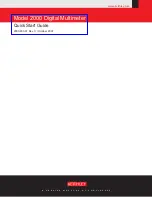
2
•
Do not use this meter if it has been damaged
•
Do not use test leads if insulation is damaged and / or wiring is exposed.
•
Use current clamps to measure circuits exceeding 20A.
•
Avoid electrical shock: do not touch probe tips.
•
Do not measure voltage with the test leads in the 20A or mA terminals.
•
When testing for the presence of voltage or current, make sure the meter is
functioning correctly. Take a reading of a known voltage or current before
accepting a zero reading.
•
Choose the proper range and function for the measurement. Do not attempt
voltage or current measurements that may exceed the ratings marked on the
function / range switch or terminal.
•
When measuring current, connect the meter in series with the load.
•
Never connect more than one set of test leads to the meter.
•
Disconnect the live test lead before disconnecting the common test lead.
•
The mA and the 20A terminals are protected by fuses. To avoid possible
injury or damage, use only in circuits limited to 600mA or 20A continuous for
15 seconds.
IMPORTANT
•
To maintain accuracy of the meter, replace the battery immediately when the
battery symbol
appears on the meter display.
•
Avoid measuring errors from outside interference: keep the meter away from
spark plugs or coil wires.
•
Avoid damaging the meter when testing voltage: disconnect the test leads
from the test points before changing functions.
•
Do not exceed the limits shown in the table below:
•
Function
Terminal
Input Limit
AC Volts
V/
Ω
/RPM
750V AC rms
DC Volts
1000V DC
Frequency / Duty
V/
Ω
/RPM
250V AC/DC
Resistance / Diode
AC / DC 600mA
600mA
600mA AC / DC
Clamp Current
600mV AC / DC
AC / DC 20A
20A
20A AC / DC
RPM, ms-PULSE
V/
Ω
/RPM
250V AC / DC
Cap, Temperature
Voltage Output
Over 1k
Ω
Resistance Output
±5V































